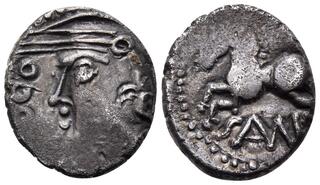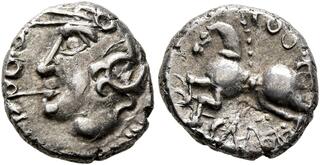Match 1:
Match 2:
| Leu Numismatik AG > Auction 15 | Auction date: 1 June 2024 |
| Lot number: 2 Price realized: This lot is for sale in an upcoming auction - Bid on this lot  | |
| Lot description: CENTRAL EUROPE. Helvetii. Viros, circa 75/50-25 BC. Quinarius (Silver, 13 mm, 1.53 g, 3 h). VIROS Celticized male bust to left, wearing torque with four pendants; staff surmounted by torque protruding from head. Rev. Horse springing left; above, carnyx to right; below, round shield decorated with a star of six rays. DT -. Frey-Kupper, Viros, Fig. 52. LT -. Nick p. 70, ill. 58, 6. SLM 875. Extremely rare and of great historical importance. The reverse struck somewhat off center, otherwise, very fine. Frey-Kupper reads the obverse legend of this highly interesting issue as VIROS, Celtic 'uiros', which translates as 'man', but certainly is, as she points out, the name of an otherwise unknown local nobleman or moneyer. The Viros-quinarii are closely connected to those in the name of Vatico, with which they share a recorded find spot in Avenches, while three other examples came to light in the vicinity of the oppidum in Altenburg-Rheinau, some 25 kilometers north of Zurich. With only about fifteen examples recorded by Frey-Kupper, the quinarius in the name of Viros is one of the great rarities in the coinage of the Helvetii, and it is one of the earliest coins ever produced in Switzerland. Estimate: 1000 CHF |  |
Match 3:
| Nomos AG > Auction 32 | Auction date: 8 June 2024 |
| Lot number: 172 Price realized: This lot is for sale in an upcoming auction - Bid on this lot  | |
| Lot description: The Anthony Milavic Collection of Ancient Games Coins Prize Wreaths Simple wreaths MAINLAND GREECE , Macedonia (?). Uncertain City. Uncertain Ruler, Circa 400-350 BC. Chalkous (Bronze, 11 mm, 1.94 g, 7 h). Head of a wolf to right. Rev. A or a monogram of ΑΜ or ΑΜΥ within wreath of somewhat spikey leaves, without any berries. BCD Peloponnesos -. BMC -. HGC 5, -. A. Milavic, A Numismatic Conundrum, The Celator, March 2005, pp. 6-12, and figs. 1-2 (this coin). Extremely rare. Well-struck and with an attractive green patina. Some areas of roughness and struck from a slightly defective reverse die, otherwise, very fine. From the collection of Major Anthony F. Milavic, USMC (Ret.), ex Gorny & Mosch 134, 11 October 2004, 1426. This coin is probably not a games coin at all (!), but it was acquired as one, and, in addition, it is so interesting that it is, none-the-less, included here. When he acquired in 2004, AM was convinced that it was a hitherto unknown coin of Argos because it bore the head of a wolf on its obverse (the usual badge of Argos - but is it a wolf?); because it had an alpha (the usual indication letter for Argos) on the reverse; and because he believed that it was struck c. 200 BC to honor either of two Argive athletes. One who won the stadion at Olympia in 224 and the other who won four consecutive diaulos races at the Olympics in 208, 204, 200 and 196 (since he viewed the wreath as being of olive, the victory had to be at Olympia rather than Nemea). He published this explanation (in The Celator of March 2005) very soon after he acquired the coin. Unfortunately for this very neat and attractive theory, there are a number of decisive objections that make it impossible. 1 The small and thick flan is very much unlike the flans produced in the late 3rd and 2nd century BCE, but it is commonly found in the first half of the 4th century. If it were struck in 4th century BC Argos, which has a fulsome coinage, how would it fit into the series? 2 The fatal objection is the form of the alpha on the reverse: it is what is known as a broken-bar alpha, because the cross bar is not horizontal but v-shaped. This is a typically late feature, which would agree with MA's late date, but which was never used at Argos, neither on Argive Hellenistic coins nor on the city's extensive Roman Provincial issues, which range from Hadrian through Gallienus. So, this coin is not from Argos. On p. 6 of MA's Celator article, we read that this coin was one of 10 pieces of the same type found in modern-day Bulgaria (to our knowledge none of the other 9 has ever appeared elsewhere), which makes an origin in the Peloponnesos highly unlikely. In addition, the letter on the reverse strongly resembles a monogram - most likely ΑΜ or, possibly ΑΜΥ (but what appears to be a Υ may just be a die break) - rather than a simple letter. This suggests that the coin might have been issued by Amyntas II (c. 394/393), who minted silver trihemiobols and bronzes with wolf foreparts on their reverses. But could this enigmatic coin be from somewhere else (where?), and could it be related to games (which?).... Starting price: 650 CHF |  |





